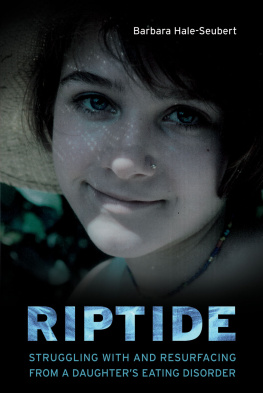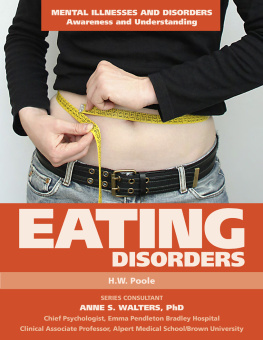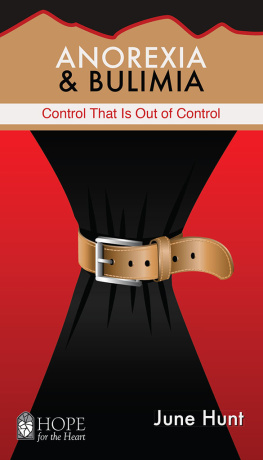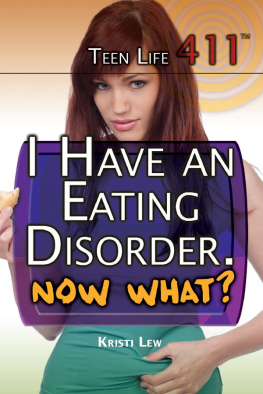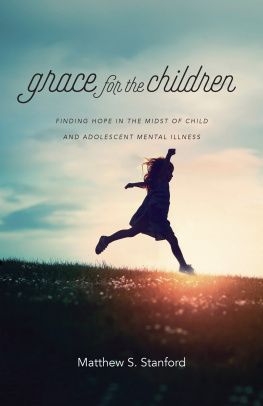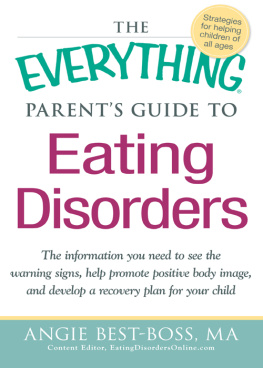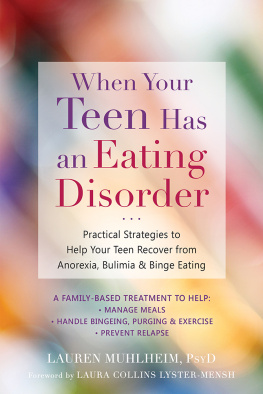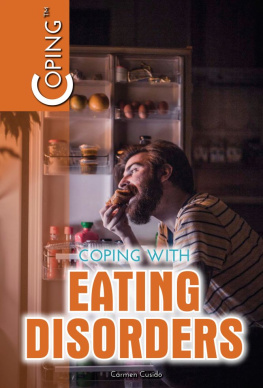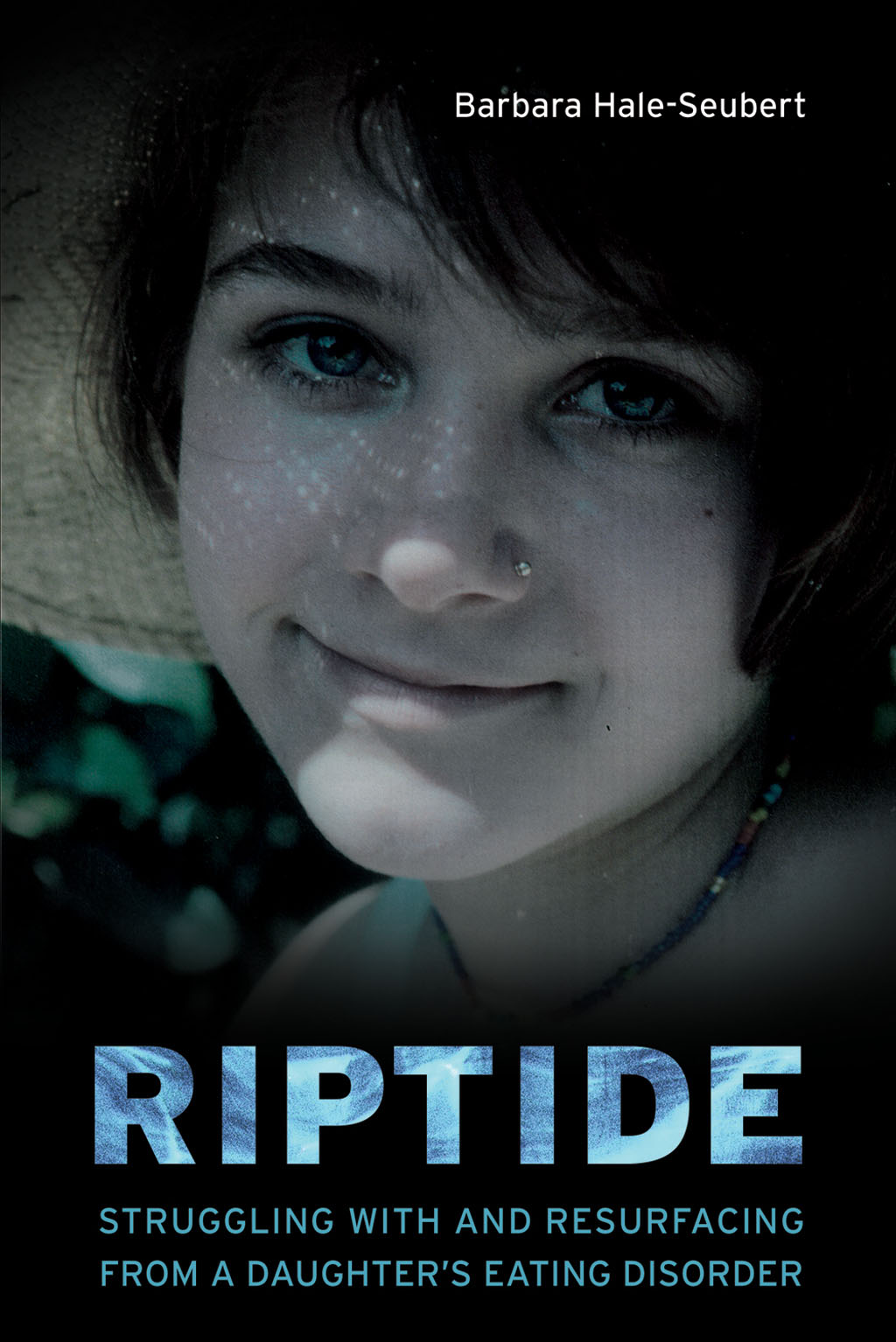Riptide
Struggling with and Resurfacing from a Daughters Eating Disorder
Barbara Hale-Seubert
ECW Press
ECW Press
Copyright Barbara Hale-Seubert, 2011
Published by ECW Press
2120 Queen Street East, Suite 200, Toronto, Ontario, Canada M4E 1E2
416.694.3348 / info@ecwpress.com
All rights reserved. No part of this publication may be reproduced, stored in a retrieval system, or transmitted in any form by any process electronic, mechanical, photocopying, recording, or otherwise without the prior written permission of the copyright owners and ECW Press. The scanning, uploading, and distribution of this book via the Internet or via any other means without the permission of the publisher is illegal and punishable by law. Please purchase only authorized electronic editions, and do not participate in or encourage electronic piracy of copyrighted materials. Your support of the authors rights is appreciated.
Library and Archives Canada Cataloguing in Publication
Hale-Seubert, Barbara
Riptide : struggling with and resurfacing from a daughters eating
disorder / Barbara Hale-Seubert.
ISBN 978-1-55490-969-8
Also issued as:
978-1-55490-906-3 (PDF); 978-1-55022-995-0 (PBK)
1. Hale-Seubert, Barbara. 2. Erin Leah, 19762000.
3. Eating disorders in adolescencePatientsFamily relationships United States. 4. Eating disorders in adolescencePatients United StatesBiography. 5. Anorexia nervosaPatientsUnited StatesBiography. 6. BulimiaPatientsUnited StatesBiography.
7. PsychotherapistsUnited StatesBiography. i. Title.
RJ506.E18H34 2011 618.9285260092 C2010-906829-7
Developing editor: Jen Hale
Cover and Text Design: Tania Craan
Typesetting: Mary Bowness
To the best of her ability, the author has recreated experiences, places, people, and organizations from her memories of them. In order to protect the privacy of others she has, in some instances, changed the names of certain people and details of events and places.
To Erin Leah, My first true love
FOREWORD
MARGO MAINE, Ph.D, FAED
Statistics are people with the tears wiped away.
Countless journal articles and books are devoted to the heartbreaking statistics ushered into peoples lives by devastating eating disorders. An Amazon search reveals nearly 30,000 books available through its website alone. This growing literature is full of faceless statistics warning us that eating disorders are affecting more and more people of all ages, from young children to senior citizens, of every race, socio-economic status, ethnicity, and gender, and in more than 40 countries worldwide. It describes the challenges of treatment and the unanswered research questions about its effectiveness. Riptide: Struggling with and Resurfacing from a Daughters Eating Disorder gets away from the numbers and puts a face on the problem a face weeping with heartbreak.
Nothing is worse than the gut-wrenching pain parents experience when watching their child suffer. This pain is magnified exponentially when the child is no longer a child and the problem is psychiatric, as the answers of diagnosis, treatment, and a path to recovery are all so elusive. There is no lullaby nor Band-Aid, no quick fix nor clarity about how to help in these situations. Although physical illness is itself a challenge to the sufferer and family, usually the treatment options and resources are mapped out and people are able to talk about the problem and receive support. Not so when the diagnosis is psychiatric, or even more complicated, as eating disorders are, spanning both the psychiatric and physical worlds.
Eating disorders are what we call biopsychosocial problems, as they have roots in each area and manifest themselves in each realm: the biological, the psychological, and the social. They have the highest morbidity and mortality rate of all psychiatric illnesses. Even the afflicted who receive good treatment and have family support along the way may end up succumbing to the ravages of these disorders. When families first encounter the diagnosis, many feel instantly overwhelmed and defeated, while others work hard to remain optimistic that their child will beat the odds. In every case, the suffering is immense, and, all too often, its compounded by a lack of understanding and compassion, in both professional and personal relationships. It can be overwhelming.
Eating disorders, at least temporarily, create a cloud or a fog around the sufferer. Once it begins, the disorder seems to have a life of its own, as starvation creates an obsession with food, emotions are translated into the language of fat, self-esteem and self-image are destroyed, and personal identity becomes wrapped around the illusion of control found in eating-disordered behaviors. I have come to see the eating disorder as a life preserver one that my patients truly feel they will drown without. The goal of treatment and the key to survival is to develop other resources to avoid that powerful feeling of terror patients experience when they believe others are trying to take their life preserver away.
For loved ones, especially parents, one of the greatest challenges brought on by eating disorders is to stay connected with this person (usually female), who now is only a shadow of her self and who rails against any efforts to break down the barrier of the eating disorder, just as anyone thrashes to hold onto a life preserver when she fears drowning. As a clinician who has specialized in treating eating disorders for the past three decades, I, too, struggle at times to stay connected, to manage my anxiety about their condition and about the likelihood I will penetrate the fog before it totally destroys her and she loses her life. I can only imagine what parents feel, as I see the pain, the confusion, the disillusionment, the guilt, and the self-doubt in my office each day.
In Riptide: Struggling with and Resurfacing from a Daughters Eating Disorder, Barabara Hale-Seubert discloses the painful struggle she experienced as the mother of a young woman who suffered and succumbed to an eating disorder. She offers no easy answers, but uses her own experience to help other families to cope with the emotional riptides and consequences of this illness. Her path was complicated by her professional role as a therapist, who was capable of helping so many people overcome the issues that brought them to her door, but often felt inept with her own daughter. Her strength, courage, and soul-baring honesty are amazing, as is her hope to enable other parents to survive the riptide and avoid drowning themselves. It is this kind of self-examination and brutal honesty that will get eating disorders out of the closets of shame and embarrassment and into the light of hope, understanding, and healing.
Despite the tragic loss of her daughter Erin, Barbara Hale-Seubert has found a way past her tears and heartbreak to find meaning, connection, and renewal. She shows us that facing pain is the only way through it, and that time helps to heal the weary souls of parents who have experienced a childs life-threatening illness. Although prompted to write because of Erins death, Barbara is truly writing about life, embracing both her daughters and her own, in all their complexity. If a story can be profoundly sad, but inspirational at the same time, Riptide: Struggling with and Resurfacing from a Daughters Eating Disorder

